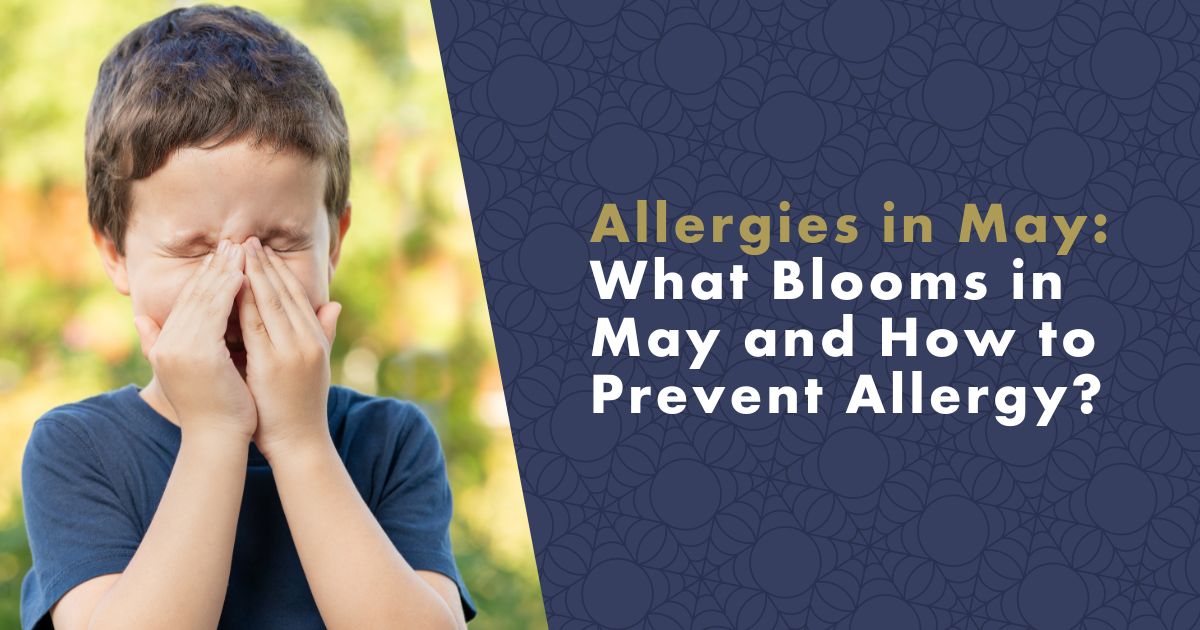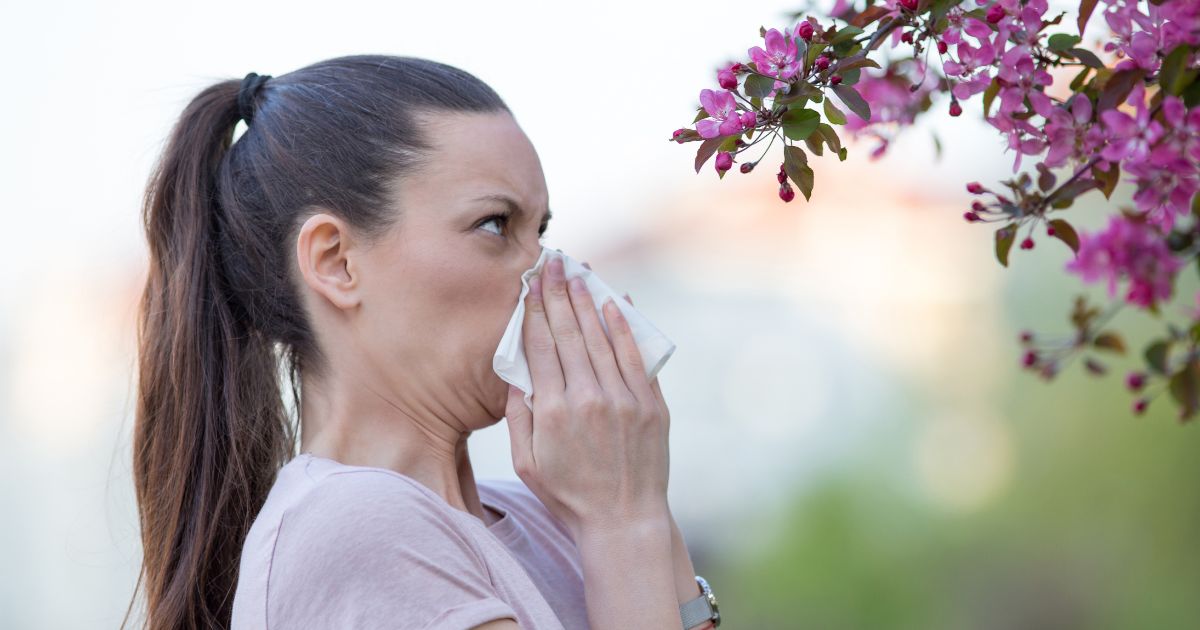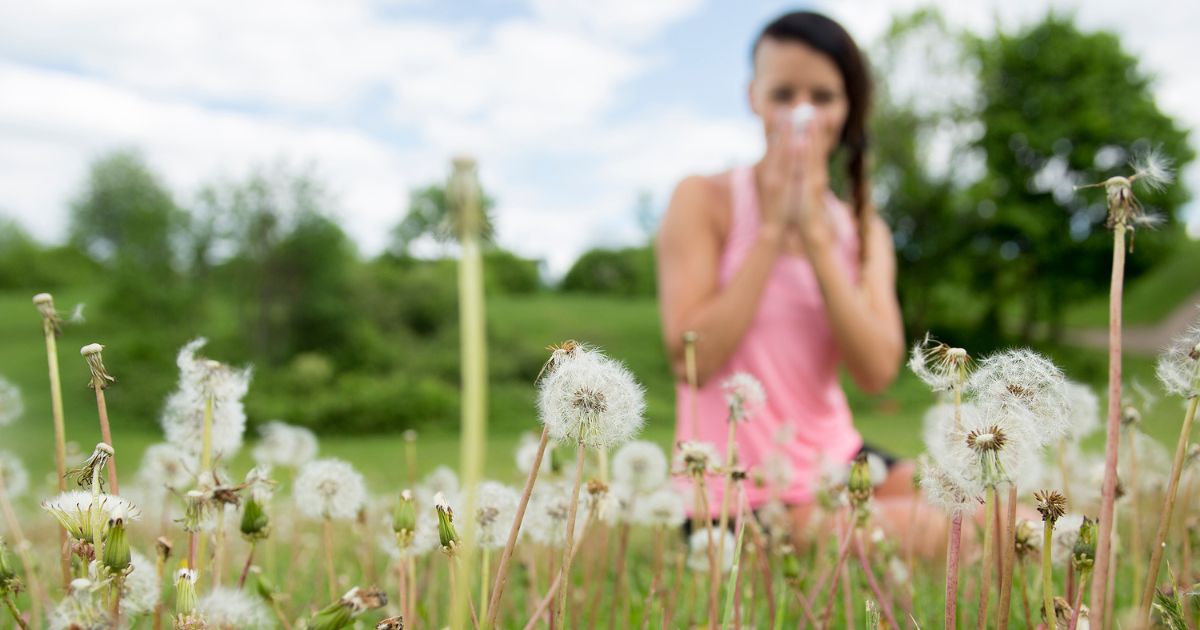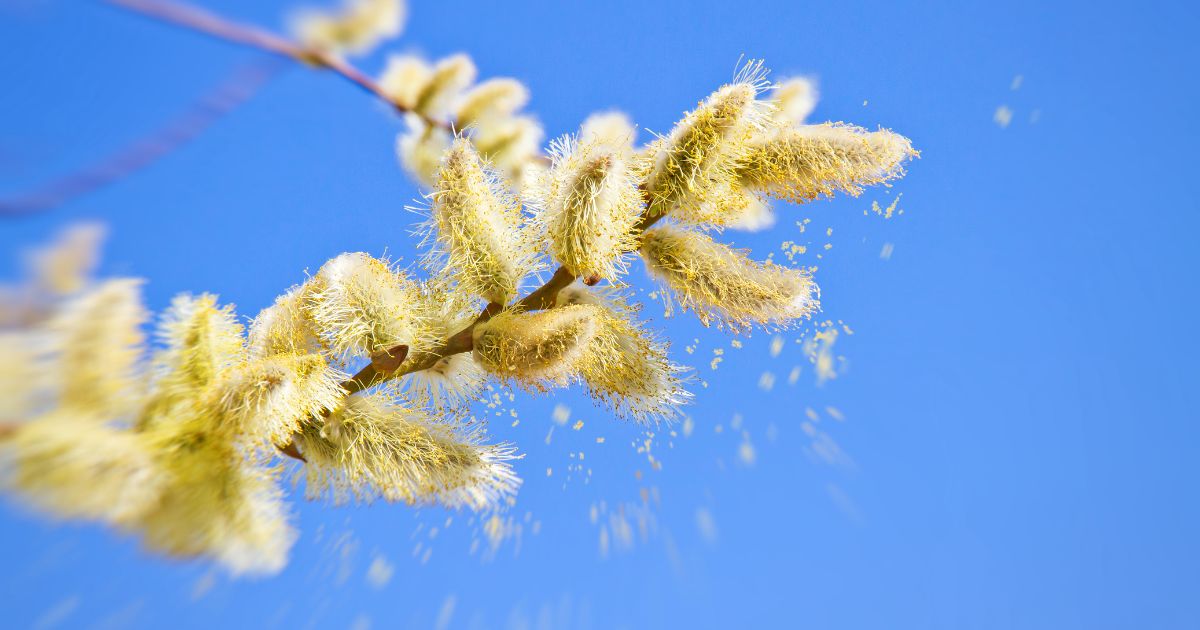May isn't just about blooming flowers—it's also prime time for allergy trouble. As nature bursts into full bloom, spring allergies gain strength, adding challenges for allergy sufferers. Mold spores and dust mites further exacerbate the seasonal discomfort. In this article, we explore the most prevalent allergens and strategies for managing spring allergies.

Spring Allergies in May and the Most Common Symptoms
Spring allergies start as early as the beginning of March, but because everything is blooming and flourishing in May, they tend to be the strongest during this month. Among the most common symptoms of spring allergies in May are various respiratory and skin problems. The main allergens are primarily tree and plant pollens, mold, and dust mites, which bother us all year round. How does spring allergy manifest in May?
- Persistent rhinitis,
- itchy and red eyes,
- itchy nose and throat,
- blocked nose,
- dry cough,
- itchy skin and rash,
- swollen face.
TIP: How to Recognize Allergy– Symptoms and Signs
What Are the Main Allergens in May
Pollen, especially from trees, flowers, and grasses, causes the most trouble, and with it, insects become more active, which can bother us. There is a large amount of various pollens and mold spores in the air, which are a nightmare for allergy sufferers.

Tip: How to Prepare for Allergy Season?
What Blooms in May
When you think of May, you feel like everything is blooming. Let's take a look at what causes the biggest trouble for allergy sufferers?
Trees
Even though most trees bloom already in April, May is no exception. The highest concentration of pollen is in forests, gardens, and parks. The most common tree allergens include:
- Pine: These conifers are characterized by their cones, which bloom from March to May.
- Birch: At the turn of March and April, birch pollen grains begin to ripen, but problems often occur until May. If you have confirmed birch pollen allergy, you will likely also be allergic to pollen from beech, oak, hazel, or alder trees.
- Beech: Beeches are deciduous trees whose flowers appear from April to May. Beech pollen is a mild allergen but still causes trouble for allergy sufferers, especially in warmer weather.
- Cypress: These conifers bloom from March to May. Their pollen is easily recognizable.
- Black Elder: Elder flowers appear from May to June. This tree is known for its aromatic flowers, which are popular with bees and often used for tea.
- Oak: Oak pollen is present in the air from April, and the flowering typically ends in May. Oak pollen is a strong allergen.
- Hornbeam: Hornbeam blooms from April to May. Its pollen is among moderately strong allergens, which, together with birch pollen, dominate the air in terms of quantity.
- Ash: Flowering ashes can release large amounts of pollen from April to May, causing allergic problems.
- Maple: Maples start blooming in April, when you can notice small yellow-green flowers blooming until May.
- Elm: Elms bloom from March to May. There are several species, and each blooms slightly differently.
- Horse Chestnut: From April to May, Horse Chestnut also bloom, emitting a strong, penetrating scent that can also be an allergy trigger.
- Walnut Tree: Be careful also with the walnut tree, which has small and inconspicuous flowers blooming from May to June.
- Linden: Linden begins to bloom in May and can bloom until July. Its flowers are fragrant and popular in herbalism, for example, for tea. Interestingly, linden trees start blooming only after 15 years of life.
Flowers, Herbs, and Grasses
Another abundant group is other plants that are in full bloom in May. These include herbs such as lichwort, ribleaf, dandelion, mustard, rapeseed, lucerne, and sorrel. From grasses, in May, you can find flowering timothy grass, foxtail grass, meadow-grass, cockfoot grass, and rye.

You might be interested: How to combat pollen allergy in spring?
Insect Allergies
May is the time when many types of insects become active outdoors, increasing the risk of allergic reactions to their stings or bites. You may commonly encounter: bees, wasps, hoverflies, bumblebees, or ants. Stings or bites from these insect species can cause local reactions such as swelling, redness, and itching, but some may lead to more severe allergic reactions.
Molds in May
In May, in some areas, it regularly and intensively rains, increasing humidity in the air. This conditions favors molds, which thrive in dark and moist spaces, such as basements, bathrooms, soil, or damp wood. There is then a greater concentration of mold spores in the air, which allergic individuals should be cautious of.
Tip: Prevent the spread of mold spores in your home easily with air purifiers for allergy sufferers.
Year-Round Dust Mite Season
With humid and warm air, dust mites also thrive, causing trouble for allergy sufferers throughout the year. And what helps with dust mites? Regularly change bedding, ventilate, and clean. However, most importantly, air purifiers will help you by removing most allergens from your home as well as anti-dust mite bedding. These are made of nanofiber fabric, which is a membrane with small pores that allergens cannot penetrate, so your duvet, pillow, and mattress will remain untouched.
#produkty#https://www.nanospace.store/anti-dust-mite-bedding/
TIP: What is nanofiber? Discover the invisible miracle that protects and heals.
What Helps with Spring Allergy in May
Because allergens increase and their quantity rises, allergy sufferers often have more trouble than in other months. Therefore, it is necessary to take measures that help reduce allergic reactions and decrease the amount of allergens in the immediate surroundings.
- Pollen calendar: As a first principle when you have an allergy, monitor a pollen allergy calendar, which tracks all allergens in each month and season. This way, you will be aware of when everything starts to bloom and what to watch out for.
- Pollen forecast: Did you know there is a pollen forecast? This way, you can avoid places where the concentration of allergens is highest (e.g., pollen concentration in the air at specific hours).
- Protective gear: To be able to enjoy time outdoors in spring and not just be confined indoors due to allergies, simply use nanomasks, nano neck gaiters, and respirators through which allergens cannot pass.
- Air purifier: So that at least at home you have a refuge where allergies don't bother you, get an air purifier for allergy sufferers, which will nicely clean the air of allergens, and you will be able to breathe. And for outdoors, get a personal air purifier to wear around your neck, which you have with you all the time and can take to work, for example.
- Nasal drops for allergies: Another solution is nasal sprays, which create a protective barrier on the nasal mucosa after application. This makes it harder for allergens to enter the body, reducing the risk of allergic reactions.
- Eye drops for allergies: Since one of the most common symptoms of allergies is itching and irritation of the eyes, eye drops come in handy.
- Household cleaning: Regular cleaning, sweeping, dusting, and changing bedding can also help because it reduces the amount of dust and allergens.
#produkty#https://www.nanospace.store/eye-drops/
TIP: Did you know there's also nano-cosmetics for household cleaning and tidying, which create a dirt-repellent layer?
Cross Allergy (Combined Allergy)
Did you know that a combination of pollen allergy with food allergy can cause what's known as cross allergy? This arises due to the similarity in the chemical composition of allergens, leading to an allergic reaction to similar proteins found in different substances. The human immune system may then mistake one substance for another, triggering an allergic reaction. Cross allergy can be particularly complicated because it can cause unexpected allergic reactions to substances we may not expect to be problematic.

TIP: You can learn more about cross allergy in our next article HERE.
For instance, someone allergic to birch pollen may experience allergic reactions to fruits such as apples, pears, or apricots because they contain proteins similar to those in birch pollen. Similarly, someone allergic to mold may react to foods fermented with mold, such as cheeses or sauerkraut, due to the similarity of allergens present in mold.
Allergy Treatment and Immunotherapy
Every allergy sufferer would undoubtedly like to get rid of their allergies, but it's not always possible. Allergy treatment typically involves the administration of antihistamines prescribed by an allergist. If you're looking for an alternative to medication, consider immunotherapy. Allergen immunotherapy (AIT) is a treatment method that involves administering small doses of allergen into the body, gradually increasing the organism's tolerance. This helps reduce allergic symptoms.
You might be interested in: Allergic Rhinitis: Symptoms and How to Recognize Hay Fever from the Common Cold
Learn More About Allergies:
- How to Recognize Allergies
- Dust Mite Allergies
- Feather Allergies
- Dust Allergies
- Identifying and Managing Allergies in Infants and Children
- Combined or Cross-Reactive Allergies
- Pollen Calendar
- How to Prepare for Allergy Season
Learn More About Allergies:
Frequently Asked Questions (FAQ)
How to recognize spring allergies in May?
Allergy sufferers recognize spring allergies by increasingly experiencing allergic reactions, most commonly involving respiratory and skin problems. The immune system triggers an allergic reaction even with a small concentration of allergens and pollen, as few as 5 pollen grains per cubic meter. When pollen season is at its peak, there can be 100 to 500 pollen grains per cubic meter.
What are the allergens in May?
The most common allergens in May include pollen, insects, dust mites, and mold.
What blooms in May?
In May, the flowering of many plants is in full swing. Many trees (pine, birch, oak, beech, hornbeam, pine, ash, black currant, elm, walnut, linden, maple, and others), grasses (timothy grass, foxtail grass, meadow-grass, cockfoot grass and rye), and herbs (lichwort, ribleaf, dandelion, mustard, rapeseed, lucerne, and sorrel) are in bloom.
When does grass allergy start?
People with pollen allergies are allergic to grasses in half of the cases. They bloom most during May, June, and July, but April is not uncommon.
How long does spring allergy last?
Spring allergies usually begin in March, when trees and some herbs bloom. However, they last until approximately autumn (10 months) because something is always blooming from spring to autumn.
Sources
- LARSEN, Jørgen Nedergaard; BROGE, Louise; JACOBI, Henrik. Allergy immunotherapy: the future of allergy treatment. Drug discovery today, 2016, 21.1: 26-37.
- PAULI, Gabrielle, et al. Efficacy of recombinant birch pollen vaccine for the treatment of birch-allergic rhinoconjunctivitis. Journal of Allergy and Clinical Immunology, 2008, 122.5: 951-960.
- Matricardi, P. M., Kleine-Tebbe, J., Hoffmann, H. J., Valenta, R., Hilger, C., Hofmaier, S., ... & Traidl-Hoffmann, C. (2016). EAACI Molecular Allergology User's Guide. Pediatric Allergy and Immunology, 27(S23), 1-250.
- REISMAN, Robert E., et al. A double-blind study of the effectiveness of a high-efficiency particulate air (HEPA) filter in the treatment of patients with perennial allergic rhinitis and asthma. Journal of Allergy and Clinical Immunology, 1990, 85.6: 1050-1057.
- BOHLE, B. The impact of pollen‐related food allergens on pollen allergy. Allergy, 2007, 62.1: 3-10.
- Bousquet, J., Anto, J. M., Bachert, C., Bousquet, P. J., Colombo, P., Crameri, R., ... & Demoly, P. (2008). Factors responsible for differences between asymptomatic subjects and patients presenting an IgE sensitization to allergens: a GA2LEN project. Allergy, 63(3), 293-303.
- Röder, E., Berger, U., & Wüthrich, B. (2003). Long-term pollen exposure and allergen sensitisation. Journal of allergy and clinical immunology, 111(1), 145-151.

